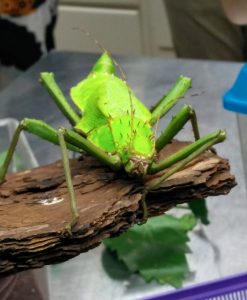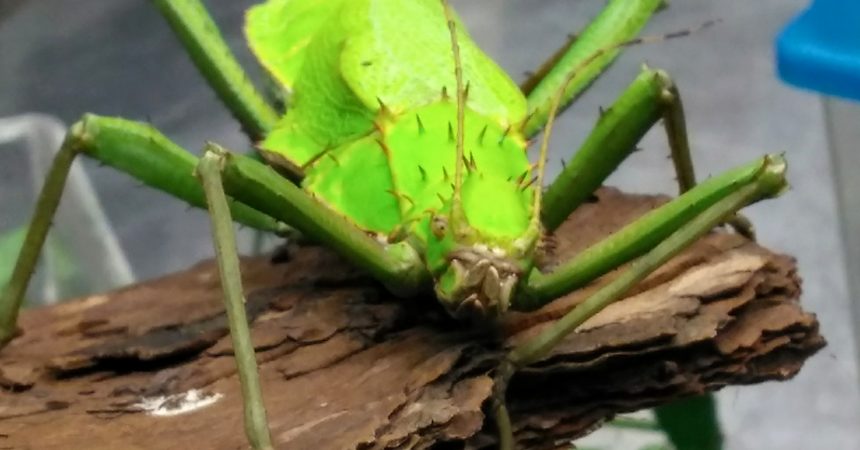Zoo InternQuest is a seven-week career exploration program for San Diego County high school juniors and seniors. Students have the opportunity to meet professionals working for the San Diego Zoo, Safari Park, and Institute for Conservation Research, learn about their jobs, and then blog about their experience online. Follow their adventures here on the Zoo’s website!
 How do you feel about bugs? Do you find them dirty, scary, or just a bit weird? I’m not saying I absolutely love bugs, but I definitely have a greater understanding of their importance after meeting Ester Chang, an Insect Keeper who has been with the San Diego Zoo for 11 years. She believes that there are many misconceptions about bugs and that the exhibit located in the Insect House helps people appreciate them.
How do you feel about bugs? Do you find them dirty, scary, or just a bit weird? I’m not saying I absolutely love bugs, but I definitely have a greater understanding of their importance after meeting Ester Chang, an Insect Keeper who has been with the San Diego Zoo for 11 years. She believes that there are many misconceptions about bugs and that the exhibit located in the Insect House helps people appreciate them.
Ms. Chang explained that there are many misconceptions people have about insects, including that they are dirty or slimy. There is also a lot of unwarranted fear surrounding bugs, which can be hard to combat. She hopes that by exposing people to bugs through the exhibit at the Zoo, they will better understand their importance. Many of the bugs housed at the Zoo are exotic, since they tend to be bigger and more interesting to the average Zoo guest. The appearance of the exhibits that house the bugs is important as well; clean, aesthetically pleasing exhibits create a better experience for those visiting the Zoo and thus help show that bugs aren’t as gross or scary as they seem.
Another part of how Ms. Chang helps counter misconceptions is through the leafcutter ant exhibit, which shows what goes on inside a colony of these highly social and organized insects. These ants are farmers and raise a fungus by feeding it leaves they collect from throughout the rainforest. They are the biggest consumer of leafy material in the rainforest despite not actually eating the leaves. They also use a pheromone based communication system, which means they use scents to relay messages throughout the colony. For example, dead ants give off a specific pheromone so that others in the colony know to take them to the trash chamber. Labor in a leafcutter ant colony is divided by age, proof that insect societies are actually very complex. The youngest ants care for the larvae and pupae, as they get older, they gather leaves for the fungus, and the oldest take care of waste generated by the colony and put it in a specific trash chamber. The leafcutter ant exhibit shows that bugs can be very neat and organized rather than dirty and gross.
Ms. Chang is also part of a project to help restore the native Quino checkerspot butterfly. This butterfly once heavily populated the San Diego area, but have since been declining. The US Department of Fish and Wildlife helps get adult butterflies into the Zoo during the Spring so that they can lay their eggs, then the young butterflies are released in different spots to help expand the range in which this species lives.
At the end of the time we spent with Ms. Chang, she introduced us to some bugs, including millipedes and Madagascar hissing cockroaches. This is something that is done in daily presentations at the Zoo to engage people’s curiosity by letting them touch some of the insects. Since it is a very ingrained reaction for people to be scared of bugs, engaging their curiosity helps people get used to the idea that bugs aren’t necessarily dirty or gross. This may help encourage people to do more for bugs once they realize that they aren’t always something to be feared. Bugs play a key role in important processes such as pollination and decomposition, helping plants to reproduce and recycle nutrients back into the environment.
How can people do more to help bugs? Avoid using pesticides since they aren’t usually necessary in the garden. To keep Argentine ants, the little black ones that seem to be everywhere, under control, try using cinnamon, peppermint, or eucalyptus oil instead. It also helps to block the hole they are using to enter the house so they can’t get back in. The most important thing is to learn about insects before trying to kill them. They’re everywhere, and we wouldn’t be here without them.
Kelsey, Conservation Team
Week Two, Fall Session 2018


